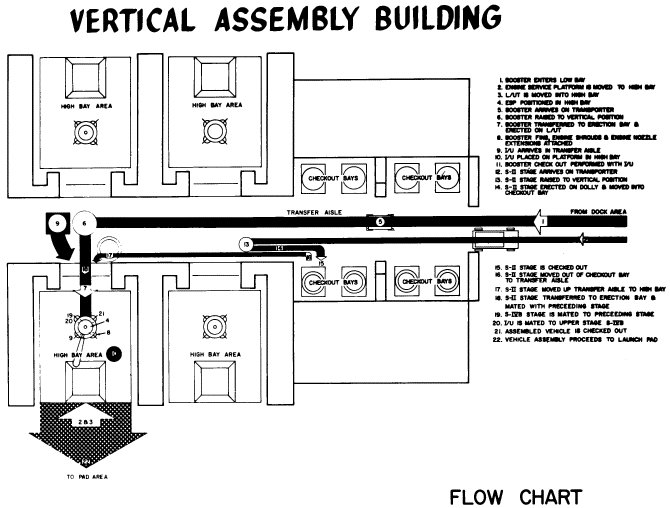
Apollo 4 was not ill-starred. In fact, it eventually went into space trailing a sizable cloud of glory. But no mission was so plagued by vexatious delay, due in part to the teething troubles of a new rocket and new stages, especially the S-II; in part, to the aftermath of the fire; and in part, to the all-up procedure which put a premium on prelaunch preparations. The delays were not unproductive. Many involved the learning of lessons that, once mastered, were needed in succeeding Saturn V launches. Some serious problems did not delay the launch. For example, early in the checkout LC-39's LOX line ruptured, threatening to hold up operations for several weeks [see chapter 15-9]. The line was repaired, and could have been repaired two or three times over, while other and more serious problems were being solved.
In mid-1966 General Phillips hoped to launch the first Saturn V early the following year. Few Apollo officials were very confident about the target date. The S-II second stage had become the pacing item in the program. Development problems had already delayed its delivery at KSC from July to October 1966. On 13 August the S-II reached the Mississippi Test Facility, only to be held up again when technicians found cracks. The discovery delayed the acceptance firings and forced Phillips to reschedule the arrival of the S-II stage at KSC for mid-November. That month the Apollo Program Office issued a revised schedule calling for delivery of the S-II stage at KSC on 9 January, with launch three months later. Meantime, checkout of the 501 vehicle proceeded without S-II. In its place the launch team employed a spacer, referred to as the "spool" because of its shape - a cylinder that flared out at both ends. With the spacer the launch team could stack the stages and begin checkout in the assembly building. The spool also gave KSC the opportunity to test handling equipment for the second stage.5

Flow chart for assembling a Saturn V.
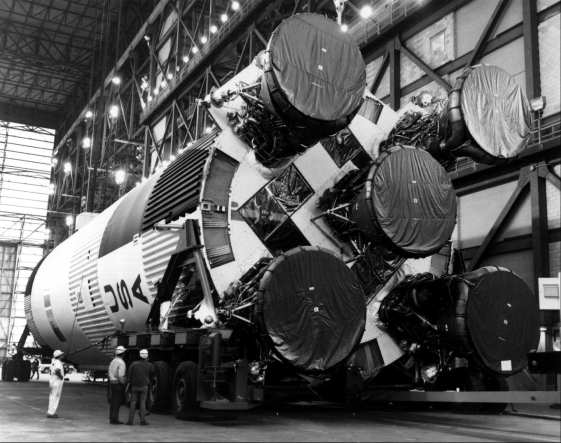
An S-IC stage in the assembly building.
The third stage (S-IVB) was the first major component of Apollo 4 to be delivered at KSC. It arrived from Sacramento aboard the Guppy aircraft on 14 August 1966 and went immediately into a low bay of the assembly building for inspection and checkout. The following week the spacer and instrument unit arrived. On 12 September, as Peter Conrad and Richard Gordon prepared to blast off in Gemini 11, the barge Poseidon sailed into the Banana River with the first stage. Boeing gave it a lengthy checkout in the transfer aisle of the high bay before erecting the booster on 27 October. During the following week, technicians stacked the remaining launch vehicle stages, using the spool for the absent S-II. There were a few problems - the checkout of the swing arms took an extra two days and a cooling unit for the instrument unit sprang a leak - but the launch team, still counting on the mid-November delivery date for the S-II, hoped to roll the complete vehicle out to pad A by 13 January 1967.6
By late November the Apollo Program Office had moved the S-II's arrival back to January, and the launch back to April. Since spacecraft 017 would not arrive for another three weeks, KSC erected the facilities verification model of Apollo on 28 November. This allowed North American to check out some of its spacecraft support equipment. The first week in December the memory core in a digital events evaluator failed after intermittent troubles; cracked solder joints were blamed. A hurried repair put the computer back on line.7
The command-service module arrived at KSC on Christmas Eve and was mated to the launch vehicle on 12 January 1967. That tardy prima donna, the S-II stage, finally appeared on 21 January. Tank inspection, insulation, and engine work were in progress by the 23rd. Test crews found damaged connectors on three recirculation pumps and set about investigating the extent of the rework that would be necessary. While inspecting the liquid hydrogen tank on the second stage, the North American team found 22 cracked gussets. These triangular metal braces, used to support the horizontal ribs of the stage framework, had to be replaced. Plans to move the second stage into a low bay checkout cell on the 29th were temporarily set aside because of a late shipment of the aft interstage (the cylindrical aluminum structure that formed the structural interface between the first and second stages). The interstage arrived on 31 January, and by the end of the next day the stage was in a low bay cell with work platforms around it.8
Despite the delay with the S-II stage, KSC officials expected to meet the new launch date in May. The fire on 27 January placed all schedules in question. Although Apollo 4 was an unmanned mission, NASA officials wanted to give command-module 017 a close examination. On 14 February, a week before the S-II could be inserted into a fully assembled vehicle, the spacecraft was removed from the stack and taken to the operations and checkout building. When inspection disclosed a number of wiring errors, KSC's Operations Office cancelled the restacking of the spacecraft. By 1 March electrical engineers had discovered so many wiring discrepancies that the test team stopped their repair work, pending a thorough investigation of all spacecraft wiring. Within two weeks the North American and NASA quality control teams recorded 1,407 discrepancies. While North American repaired about half of these on the spot, modifications, repair work, and validations continued into June. During the break technicians performed pressure tests on service module systems at pad 16. It would be mid-June, with the wiring modifications for the command module finally completed, before North American could remate the spacecraft and take it back to the assembly building.9
As the extent of the wiring problems was not immediately recognized, the launch vehicle team forged ahead to recoup the time lost on the S-II stage. In mid-February Boeing's airframe handling and ordnance group removed the instrument unit and spacer from the 501 stack and on the 23rd erected the S-II. The operation involved incredibly close tolerances. To qualify crane handlers, Stanley Smith, Bendix senior engineer of the crane and hoist group, stated, "We give them a technical examination and then check their reflexes and response to commands in training sessions." During a mating, an operator and an electrician boarded the crane and another man helped guide movements from the floor by communicating with the operator via a walkie-talkie. Smith set a high goal for his team: "We strive to train our men to the point where they could conceivably lower the crane hook on top of an egg without breaking the shell."10
After a stage was properly aligned on the Saturn stack, a crew of one engineer, two quality control inspectors, one chief mechanic, and eight assistants took eight hours to complete the mating. Three 30-centimeter pins on the second stage fitted into brackets located 120 degrees apart on the periphery of the first stage. Then the mechanics inserted 216 one-centimeter, high-strength fasteners into matching holes around the perimeter where the two stages joined. The team torqued the fasteners in a staggered sequence to secure the bolts evenly and ensure a uniform distribution of stress. The mating of the second and third stages was conducted in much the same manner.11 The 501 was now set up except for the missing CSM.
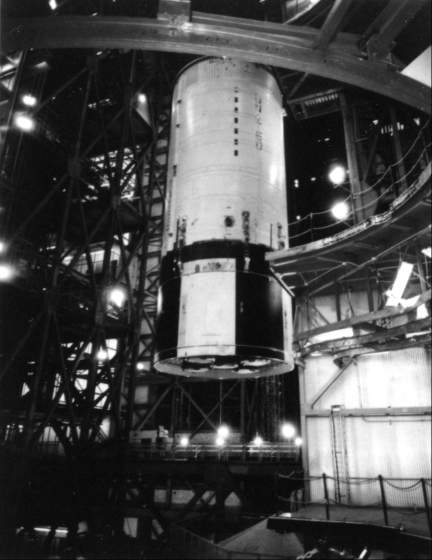
Stacking the space vehicle. The piece by piece buildup of the space vehicle in the assembly building. (1) The S-II is placed on top of the S-IC.
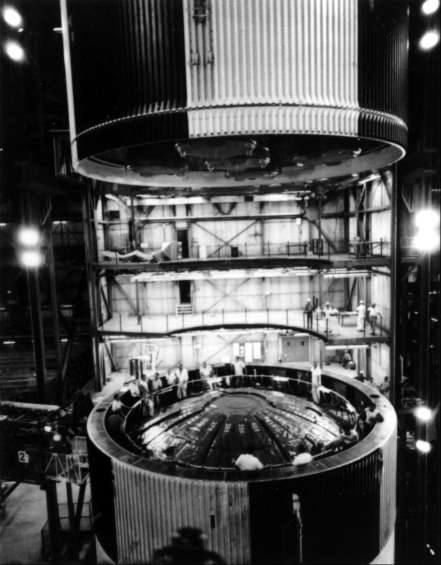
Stacking the space vehicle. (2) The S-II is placed on top of the S-IC.
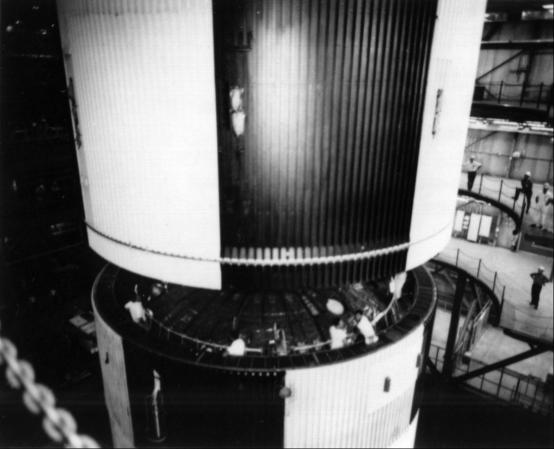
Stacking the space vehicle. (3) The S-II is placed on top of the S-IC.
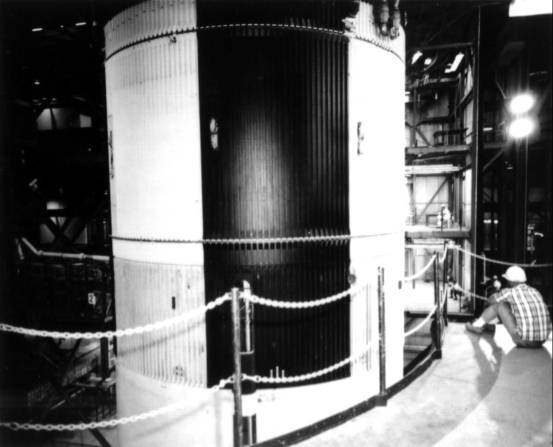
Stacking the space vehicle. (4) The S-II is placed on top of the S-IC.
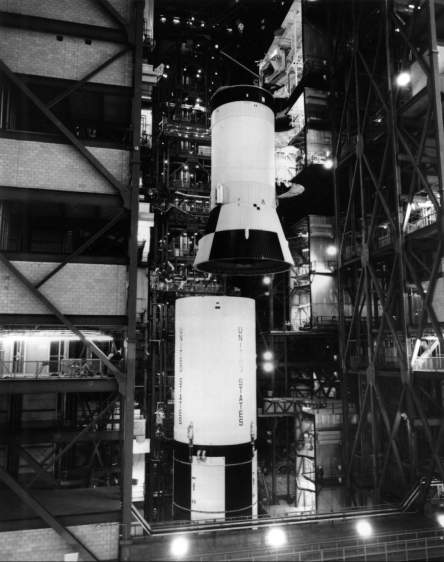
The S-IVB goes on the S-II.
The lengthy delays with the flight hardware aided the Site Activation Board in its efforts to get LC-39 ready for its first launch. The board's first flow [see chapter 15-1] included firing room 1, mobile launcher 1, high bay 1, and the other facilities required for the support of Apollo 4 - 1,280 activities altogether. During the first quarter of 1967, PERT charts showed less than 1% of these activities behind schedule. The decision in mid-April to modify the LOX system on launcher 1 and pad A put five weeks of negative slack into the site activation schedule. The modifications were made necessary by excessive pressure in the LOX system. KSC engineers added an automatic bleed system, relief valve supports, and a block valve that prevented purging through the drain line. As continued vehicle problems further delayed the rollout, the five weeks of negative slack disappeared.12
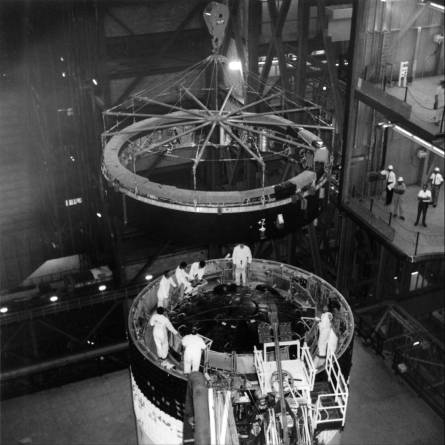
In the upper reaches of the assembly building, the instrument unit is added to the stack.
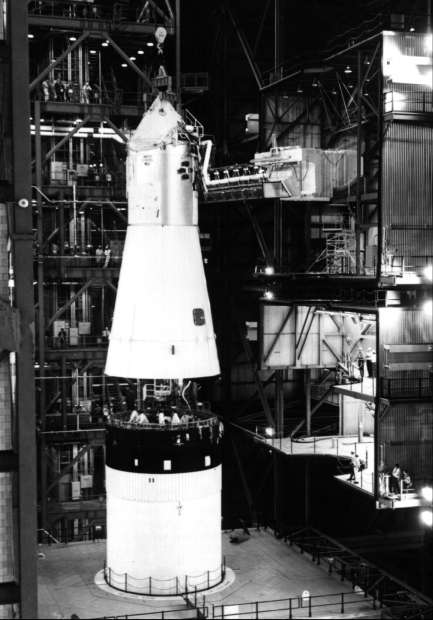
The last major piece is the Apollo spacecraft, which rests on the instrument unit. An extensible work platform has been moved up to the vehicle at the S-IVB level.
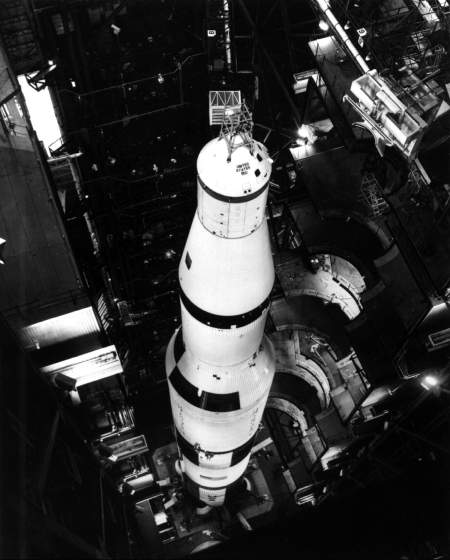
The view from the top of AS-501, with the work platforms retracted, May 1967. Access arms 8 and 9 are visible at the top. The top-most piece - the launch escape rocket - has not been installed.
On 24 May the S-II stage was in trouble again. NASA announced it would be dismantled for inspection, consequent on the discovery of hairline cracks in the propellant tank weld seams on another S-II at the factory in California. The additional checks were not expected to delay the flight of 501 "more than a week or so." By mid-June the inspection, which included extensive x-ray and dye penetrant tests, was completed and the stage returned to the stack. On 20 June, the command-service module was mechanically mated to the Saturn V, and 501 was - at last - a fully assembled space vehicle. A revised schedule on 21 July set rollout for mid-August. On 26 August 1967, the big rocket emerged from the high bay slightly more than a year after its first components had arrived at KSC, and a good six months after its originally scheduled launch date. It had been a year of delay and frustration, and the end was not yet.13


